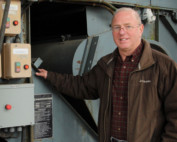N ew Yorkers who are thinking about growing a small plot of hops on their property often call Steve Miller EFB ’74 for advice. People thinking about launching a 50-acre hops-growing operation also call him, reaching him in his Morrisville, New York, office from as far away as Ohio or Michigan.
Hops growers from all over the northern and eastern United States have learned from Miller, as have would-be producers of the crop in Europe. They ask about planting practices, pest management and harvesting equipment. Brewers call to ask how they can find local sources for their ingredients.
Miller answers their questions. He also checks the progress of hops plants growing in four greenhouses in North Syracuse and consults with Dr. William Smith at ESF about increasing rot resistance in the 22-foot wooden poles that form the framework for hops yards. He traveled to Poland to check out machinery — dryers, balers and tillage equipment — that might be useful in Central New York, and he works with a local manufacturer that is looking to produce a mobile hops picker.
He also teaches growers about integrated pest management, puts out a newsletter for growers, runs educational workshops, speaks at conferences, communicates with both the state Department of Environmental Conservation and loggers about tree species most suitable for use as poles in hop yards, and is a co-author of the Cornell Integrated Hops Production Guide. On a lighter note, he was crowned “Madison County Hop King” 2013. The title is bestowed annually at the Madison County Historical Society’s Annual Hop Fest upon an individual who honors the county’s hops heritage.
“I’m the only one doing it at this level,” said Miller, the first person to hold the position of hops specialist with Cornell Cooperative Extension of Madison County. “My job is different every day. People call me from all over the Northeast. I’ve had people call me from Uruguay, wanting to put in a hop yard. I’ve been interviewed by German newspapers and by CNN. There’s a lot of interest in growing hops.”
Miller fields the requests from an office just down the road from SUNY Morrisville. He took on the hops responsibilities for Cornell Cooperative Extension about five years ago, after working for Cornell’s Geneva Experiment Station doing plant pathology research and then with the cooperative extension office in Oneida County, where he conducted programs on commercial horticulture. Now his attention is focused 100 percent on hops, the flowers that grow on bines (plants that climb by growing shoots around a support structure, as opposed to vines that grow using tendrils and suckers) and give beer its distinctive taste.
“In the last 15 years, the craft breweries have really taken off, and that’s opened up a lot of opportunities for these small hops growers,” he said.
The increasing number of craft breweries in New York, and the related interest in growing hops, offer an opportunity for a lesson in the state’s agricultural heritage. In the mid-19th century, Central New York was a leader in hops production;
21 million pounds of dry hops were produced annually on 40,000 acres at the industry’s peak, around 1880.
That changed in the early 20th century, when a disastrous fungus hit the plants, followed by Prohibition, which shut down the need for beer ingredients. When Prohibition ended in 1933, the hops industry resurfaced on a large scale in the Pacific Northwest.
Now, fueled by support from the state’s creation in 2012 of a farm brewery license that encourages craft brewers to use products grown in New York state, the growing of hops is enjoying a modest resurgence in New York. To hold the farm brewery license, a brewery must buy 20 percent of its ingredients from New York growers. The amount will increase to 60 percent in 2019 and 90 percent in 2024.
When Miller began working as hops specialist, he said, there were 15 acres of hop yards in Central New York. Now there are more than 350 acres, at an investment of about $20,000 per acre. The state’s craft beer industry grew 59 percent from 2013 to 2014, according to a report prepared by Stonebridge Research Group and released by Gov. Andrew Cuomo. Miller said the nation’s craft breweries will create enough demand in the next five years to support an additional 12,000 acres of hop yards. “We are not going to get all of that in New York,” he said. “If we could get 1,000 acres, that would be good.”
Hops, which resemble pine cones, grow on bines supported by a trellis some 18 feet tall. They provide beer with aroma and flavor, particularly its trademark bitterness. They also contain antimicrobial and antifungal properties that help preserve beer.
“You’re producing chemistry to flavor things,” Miller said. “There is a lot of chemistry to brewing. Anybody can make alcohol. It’s making beer that someone wants to buy that’s a challenge.”
Tending the state’s hops operation grew out of Miller’s interest in plants, which led him to enroll at ESF at the height of the environmental movement in the early 1970s. He followed that with a master’s degree from Clemson University, where he studied pomology and entomology. He said his environmental education gave him a unique perspective on the use of pesticides and gave him knowledge that enhances his conversations with the DEC, loggers and Smith.
“The science education I got at ESF was probably the most valuable thing,” he said. “I definitely approach my work from an environmental perspective. You get a really good education at ESF and there is a lot you can do with it.”











